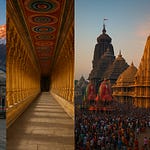Nestled in the heart of Old Delhi, directly opposite the imposing Red Fort, stands the iconic Shri Digambar Jain Lal Mandir — the oldest Jain temple in India’s capital city. Known for its red sandstone façade, peaceful sanctity, and a deep sense of compassion for all living beings, Lal Mandir is more than just a religious site. It is a symbol of non-violence, heritage, and spiritual awakening amidst the chaos of Chandni Chowk.
📜 Origin and Historical Timeline
Establishment: 1656 CE
The temple traces its origins to the Mughal era under Emperor Shah Jahan.
It was originally a small prayer hall for the Jain soldiers in the Mughal army.
As Jain merchants and soldiers gained prominence, the temple was expanded and formally established as a Digambar Jain temple.
Architectural Significance
Built with striking red sandstone, its vivid exterior earned it the name “Lal Mandir” (Red Temple).
It exemplifies the Mughal-era Jain architectural fusion, with its carved pillars, domes, sanctums, and marble floors.
🧘♂️ Religious and Spiritual Significance
Deity Worshipped
The temple is dedicated to Lord Mahavira, the 24th Tirthankara of Jainism.
It also houses idols of other Tirthankaras like Lord Parshvanatha, Lord Rishabhanatha, and more, each displayed with spiritual elegance.
Core Philosophies
The temple embodies the Jain principles of:
Ahimsa (Non-Violence)
Satya (Truth)
Aparigraha (Non-Possession)
Anekantavada (Multiplicity of Views)
🪷 Puja, Rituals, and Satsangs
Daily Puja
Begins early at 5:30 AM with Prabhat Arti (morning ritual).
Devotees perform Abhisheka (ritual bathing of idols) using milk, water, and saffron.
Offerings include fruits, flowers, rice, sandalwood, and incense.
Ritual Practices
Samayik: A spiritual practice of equanimity performed daily.
Pratikraman: A ritual of introspection, repentance, and self-purification.
Sutras Recitation: Jain scriptures and chants recited in groups.
Daan (Charity): Integral to Digambar tradition — includes giving food, medicine, and support to animals and the needy.
Satsangs
Weekly Satsangs and discourses are held by Jain monks and scholars.
Themes include Jain ethics, meditation, karma theory, and spiritual evolution.
🎉 Major Festivals Celebrated
Mahavir Jayanti (March-April)
Grandest celebration honoring the birth of Lord Mahavira.
Includes processions, community meals (Ahimsa Bhoj), and sermons.
Paryushan Parva (August-September)
An 8-day festival of penance, fasting, and reflection.
Ends with Kshamavani Diwas – the day of seeking and granting forgiveness.
Diwali (October-November)
Celebrated as the Nirvana Day of Lord Mahavira.
Devotees light lamps, fast, and meditate.
Kartiki Purnima
Pilgrimages, religious lectures, and charity are practiced.
🐦 Jain Birds Charity Hospital – A Symbol of Compassion
One of Lal Mandir’s most unique features is the Jain Birds Charity Hospital located in its premises.
Established in 1929, it is the world’s oldest bird hospital.
Founded on Jainism’s belief in universal compassion (Jeev Daya).
Injured and sick birds are admitted, treated by avian specialists, and released after recovery.
The hospital cares for pigeons, parrots, eagles, sparrows, and even squirrels.
Open daily, the hospital is a silent guardian of voiceless creatures.
🏛️ Temple Architecture and Layout
Constructed in North Indian Jain style, the temple’s red sandstone walls are adorned with intricate carvings and peaceful courtyards.
The inner sanctum is calm, with marble idols, oil lamps, and brass lamps.
The Shikharas (domes) rise in traditional temple style, making it visible from afar.
📍 Travel Guide and How to Reach
Location:
Situated in Chandni Chowk, right opposite the Red Fort (Lal Qila).
Nearest Metro Station:
Lal Quila Metro (Violet Line) – 2-minute walk.
Chandni Chowk Metro (Yellow Line) – 10-minute walk.
Best Time to Visit:
Early mornings or evenings for calm, meditative experience.
Visit during Mahavir Jayanti or Paryushan Parva for a spiritual deep-dive.
Timings:
Temple: 6:00 AM – 9:00 PM daily.
Birds Hospital: 8:00 AM – 8:00 PM (Open to visitors in the evening).
Entry Fee: Free (donations accepted).
Photography: Not allowed inside the sanctum.
🙏 Visitor Etiquette
Remove shoes before entering the premises.
Dress modestly and maintain silence in prayer areas.
Respect rituals in progress and avoid touching idols.
Do not bring leather items or eatables inside.
Refrain from using mobile phones within the temple.
🧭 Insights & Reflections
A Living Heritage: Lal Mandir bridges ancient Jain philosophies with modern humanitarian values.
Soul of Old Delhi: In the bustling lanes of Chandni Chowk, it offers peace, purity, and purpose.
Spiritual Tourism: A must-visit for seekers of knowledge, architecture lovers, and spiritual wanderers.
Symbol of Non-Violence: Its bird hospital is a living testimony to Ahimsa in action.
The Shri Digambar Jain Lal Mandir is not just Delhi’s oldest Jain temple — it is a living narrative of India's pluralism, spirituality, and compassion. With every chant echoing through its sanctum and every wounded bird healed in its hospital, the temple breathes life into Jainism’s timeless values. Whether you’re a pilgrim, a history buff, or a cultural traveler, Lal Mandir offers an unforgettable journey through faith, kindness, and peace.










